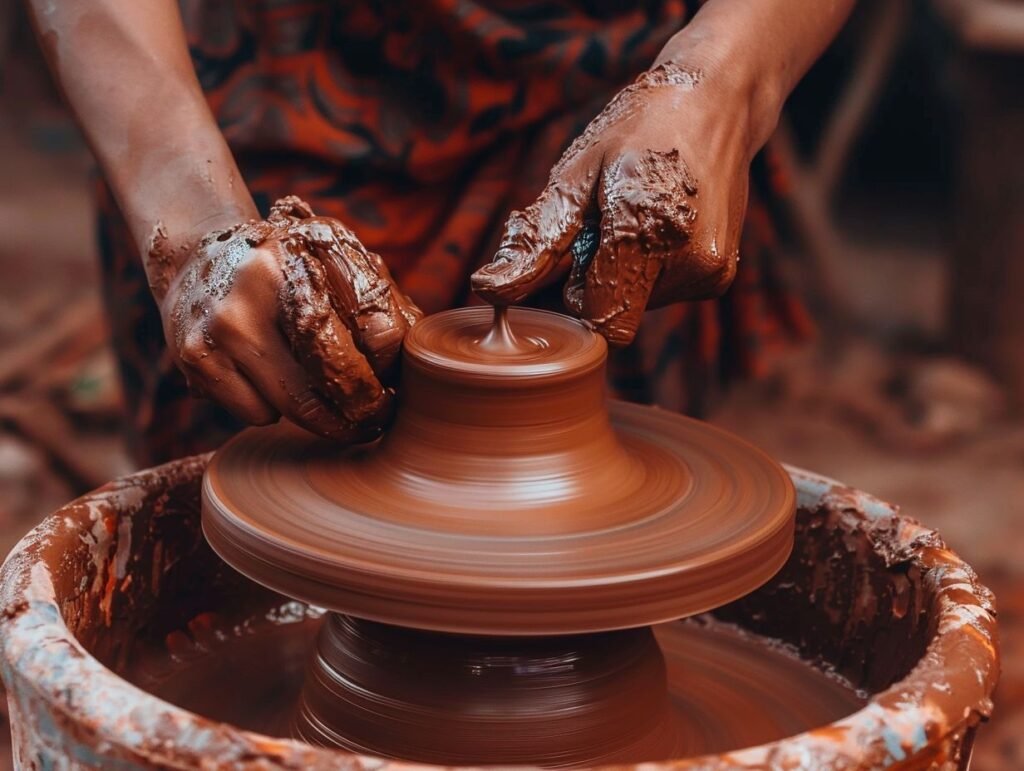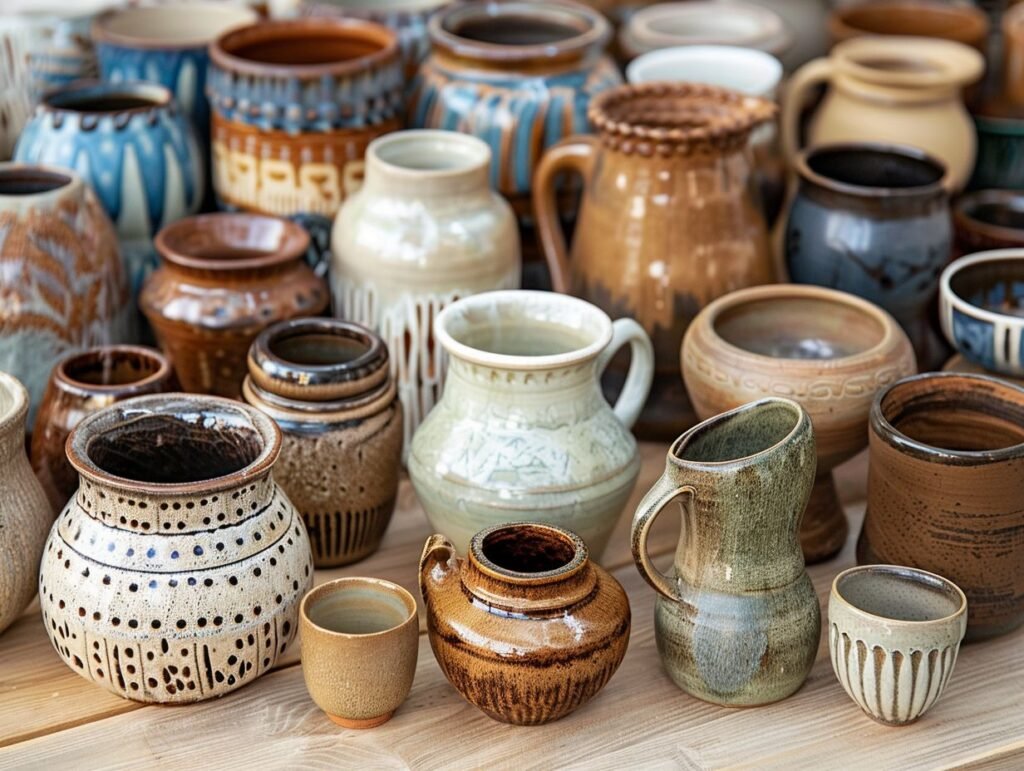Pottery has been a part of human history for thousands of years. It’s a craft that has evolved over time, from simple clay pots to beautiful works of art. Pottery has played a significant role in the development of civilizations around the world, serving practical purposes as well as being used in religious ceremonies and trade. In this article, we’ll take a journey through the history of pottery, from its earliest beginnings to its place in the modern world.
Early Pottery (10,000 BCE – 3,000 BCE)

The earliest known pottery dates back to around 10,000 BCE, during the Neolithic era. At this time, humans were beginning to settle in permanent communities and develop agriculture. Pottery was created out of a need for storage containers and cooking vessels. The first pots were made by hand, using a technique called “coiling,” where long, snake-like rolls of clay were stacked and smoothed together to form a pot.
The earliest pottery was simple and functional, but over time, people began to decorate their pots with designs and patterns. This marks the beginning of pottery as an art form. Different cultures developed their own unique styles of pottery, using locally available materials and techniques. For example, the Jomon people of Japan created pots with intricate cord-marked designs, while the Yangshao culture of China produced pots with painted geometric patterns.
Pottery played a significant role in the development of early civilizations. It allowed for the storage and transportation of food and other goods, which facilitated trade and the growth of communities. Pottery also had religious and ceremonial significance, with some pots being used in burial rituals or as offerings to the gods.
- Early Pottery (10,000 BCE – 3,000 BCE)
- Ancient Pottery (3,000 BCE – 500 CE)
- Medieval and Renaissance Pottery (500 CE – 1600 CE)
- The Age of Exploration and Colonialism (1600 CE – 1900 CE)
- Modern and Contemporary Pottery (1900 CE – Present)
- Conclusion
- Frequently Asked Questions
- What is the oldest known pottery in the world?
- How did pottery production change with the introduction of the potter's wheel?
- What are some of the most famous pottery styles throughout history?
- How has the role of pottery changed in modern times?
- What are some of the most common materials used in pottery production today?
Ancient Pottery (3,000 BCE – 500 CE)

As civilizations developed and grew, so did the art of pottery. In ancient Egypt, pottery was used for a wide range of purposes, from storing grain to holding precious oils and perfumes. The Egyptians developed a type of pottery called faience, which was made from crushed quartz and other materials and had a bright, colorful glaze.
In Mesopotamia, pottery was an important part of daily life and was used for everything from cooking and storage to religious ceremonies. The Mesopotamians were skilled potters and created a variety of vessel types, including bowls, cups, and jars. They also developed new techniques for decorating their pottery, such as using a potter’s wheel to create more symmetrical and refined shapes.
In ancient China, pottery reached new heights of artistry and sophistication. The Chinese developed a type of pottery called porcelain, which was made from a special type of clay that produced a white, translucent, and extremely hard-wearing material. Porcelain was highly prized and was used to create everything from delicate tea cups to large vases and sculptures.
Pottery also played a significant role in trade during this time period. As civilizations grew and expanded, they began to trade with each other, exchanging goods like pottery, textiles, and spices. Pottery was a valuable trade commodity, with different regions producing their own unique styles and techniques.
Medieval and Renaissance Pottery (500 CE – 1600 CE)

During the Middle Ages, pottery continued to evolve and develop. In the Islamic world, pottery reached new heights of artistry and sophistication. Islamic potters developed a type of pottery called lusterware, which had a metallic glaze that shimmered in the light. They also created intricate designs and patterns using a technique called “slip-trailing,” where liquid clay was used to create fine lines and details.
In Europe, pottery production was heavily influenced by the Islamic world. During the Renaissance, European potters began to experiment with new techniques and styles, creating more elaborate and decorative pieces. The Italian city of Deruta became famous for its maiolica pottery, which featured bright colors and intricate designs.
The Renaissance also saw the emergence of distinctive regional styles of pottery. In England, for example, the town of Staffordshire became known for its salt-glazed stoneware, while in France, the city of Nevers produced a type of pottery called faience, which was characterized by its white glaze and blue decorations.
The Age of Exploration and Colonialism (1600 CE – 1900 CE)
The Age of Exploration and Colonialism brought about significant changes in the world of pottery. As European nations began to explore and colonize new lands, they encountered new cultures and traditions, including new styles of pottery. This led to a cross-pollination of ideas and techniques, with potters from different regions influencing and inspiring each other.
One of the most significant developments during this time period was the introduction of porcelain to Europe. Porcelain had been invented in China centuries earlier, but it was not until the 16th century that Europeans learned how to make it themselves. The first European porcelain factory was established in Meissen, Germany in 1710, and soon other factories began to spring up across the continent.
The popularity of porcelain had a major impact on the European pottery industry. Many potters began to imitate the style and techniques of Chinese porcelain, creating their own versions of blue and white pottery. This led to a decline in the production of traditional earthenware and stoneware, as consumers increasingly demanded the fine, white porcelain that was seen as a symbol of luxury and sophistication.
The rise of industrialization in the 19th century also had a significant impact on the pottery industry. With the invention of new machines and techniques, it became possible to mass-produce pottery on a scale that had never been seen before. This led to a decline in the number of small, independent potteries, as larger factories began to dominate the market.
Modern and Contemporary Pottery (1900 CE – Present)

In the 20th century, pottery continued to evolve and change. The influence of modern art movements like Art Nouveau and Art Deco can be seen in the designs and styles of pottery from this time period. Potters began to experiment with new materials and techniques, such as using electric kilns and incorporating mixed media into their work.
In the post-World War II era, there was a renewed interest in handmade pottery and ceramics. Artists like Bernard Leach and Shoji Hamada helped to popularize the idea of the “studio potter,” who created unique, one-of-a-kind pieces using traditional techniques.
Today, pottery continues to be an important part of the art world. Contemporary potters are pushing the boundaries of the medium, experimenting with new forms, glazes, and firing techniques. Some potters are using 3D printing technology to create complex and intricate designs, while others are exploring the use of alternative materials like paper clay and recycled materials.
Despite these innovations, the basic techniques and processes of pottery have remained largely unchanged for thousands of years. Pottery is still created by hand, using the same basic tools and methods that were used by ancient potters. This connection to the past is part of what makes pottery such a fascinating and enduring art form.
Conclusion
The history of pottery is a long and fascinating one, spanning thousands of years and countless cultures and traditions. From its origins as a simple craft born out of necessity to its evolution into a highly valued art form, pottery has played a significant role in the development of human civilization.
Through the centuries, potters have continually experimented with new techniques, materials, and styles, pushing the boundaries of what is possible with clay. Today, pottery continues to be an important part of the art world, with contemporary potters exploring new forms and concepts while still maintaining a connection to the rich history and traditions of the past.
As we look to the future, it is clear that pottery will continue to evolve and change. With new technologies and materials constantly emerging, the possibilities for innovation and experimentation are endless. At the same time, the basic techniques and processes of pottery will likely remain unchanged, as they have for thousands of years. This balance between tradition and innovation is what makes pottery such a dynamic and enduring art form, and one that will continue to captivate and inspire us for generations to come.
Frequently Asked Questions
What is the oldest known pottery in the world?
The oldest known pottery in the world dates back to around 20,000 years ago, during the Paleolithic era. These early pots were simple in design and were likely used for storing food and other goods.
How did pottery production change with the introduction of the potter’s wheel?
The introduction of the potter’s wheel, which was invented in Mesopotamia around 3,500 BCE, revolutionized pottery production. With the wheel, potters could create more symmetrical and standardized vessels in a fraction of the time it took to hand-build them. This led to an increase in production and a decrease in the price of pottery, making it more widely available to the general population.
What are some of the most famous pottery styles throughout history?
There have been many famous pottery styles throughout history, each with its own unique characteristics and techniques. Some of the most well-known include Chinese porcelain, Greek black-figure and red-figure pottery, Japanese raku ware, and Mexican Talavera pottery.
How has the role of pottery changed in modern times?
In modern times, pottery has evolved from a primarily functional craft to a highly valued art form. While pottery is still used for practical purposes like cooking and storage, it is also widely collected and displayed as decorative art. Many contemporary potters are pushing the boundaries of the medium, experimenting with new forms, glazes, and concepts.
What are some of the most common materials used in pottery production today?
The most common material used in pottery production today is clay, which can be found in a variety of forms and colors. Other materials commonly used include porcelain, stoneware, and earthenware. Some potters also experiment with alternative materials like paper clay, glass, and even concrete.


